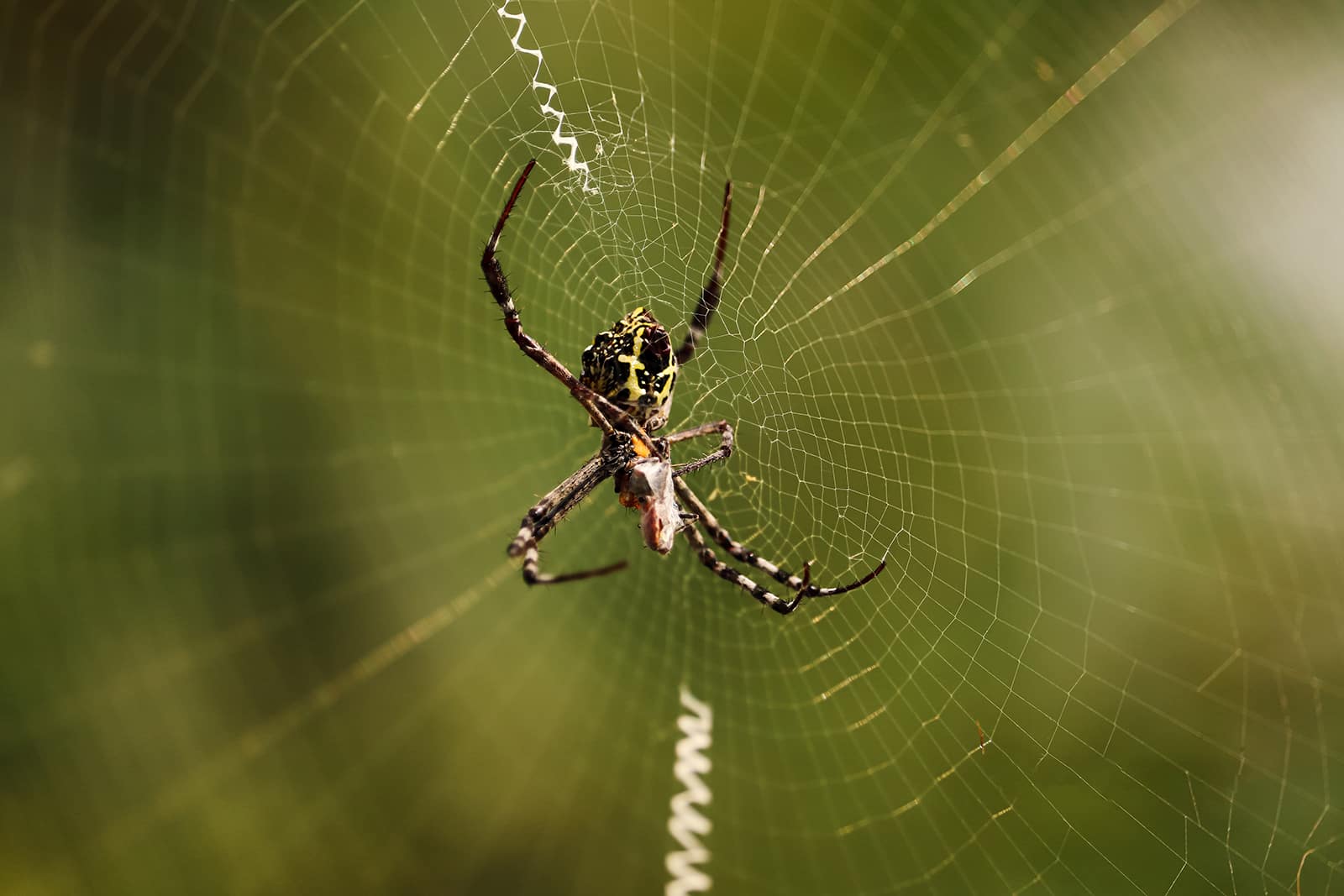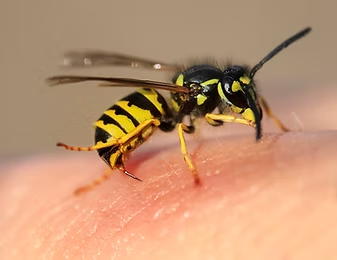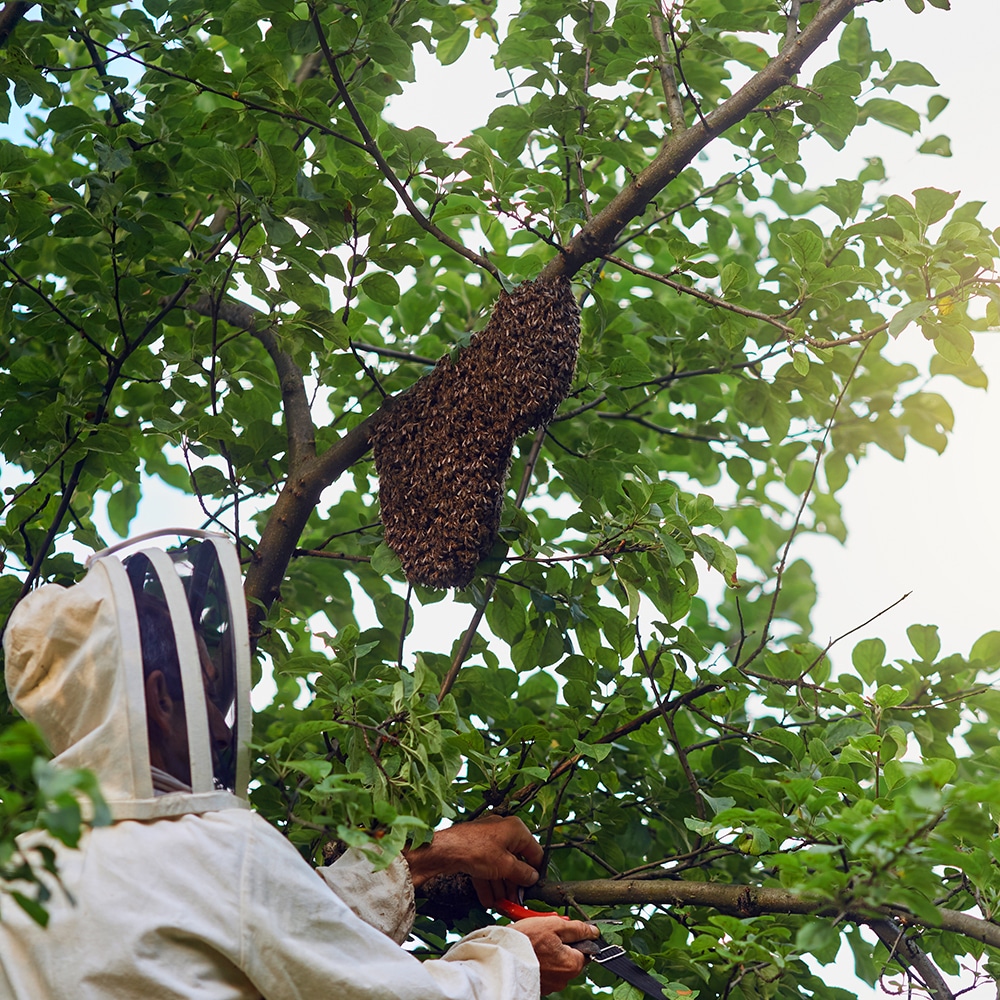
Why Do Spiders Come Back And Why
Why Do Spiders Come Back And Why On The Central Coast NSW. Responsive Proactive Solutions. Detail-focused for lasting results. Call Adam on 0431 222 894
Wasp Stings and Allergic Reactions What You Need to Know can be daunting, but understanding them helps. If you’re on the Central Coast NSW, Vital Pest Control offers reliable and detail-focused solutions to keep you safe.
How to identify a wasp sting
Wasp stings are sharp and cause immediate pain. Look for a red bump with a white centre. Swelling may occur.
Differences between wasp and bee stings
Bee stings leave a barbed stinger behind, while wasp stings don’t. Wasps can sting multiple times.
Why wasp stings are more painful than bee stings
Wasp venom contains pain-inducing chemicals. Their aggressive nature also means frequent stings.
What to do immediately after a wasp sting
Remove tight jewellery and wash the area with soap. Apply a cold pack to reduce swelling.
Signs of an allergic reaction to wasp stings
Watch for hives, difficulty breathing, or dizziness. These signs need immediate attention.
When to seek medical attention for a wasp sting
If symptoms worsen or you experience an allergic reaction, seek medical help quickly.
How to prevent wasp stings when outdoors
1. Avoid wearing bright clothes.
2. Keep food covered.
3. Stay calm if a wasp approaches.
Best home remedies for wasp stings
Baking soda paste can soothe stings. Vinegar helps neutralise venom and reduce pain.
For proactive solutions on the Central Coast NSW, trust Vital Pest Control. Discover how we can help you today!

Wasps are common in Central Coast NSW, and their stings can be both painful and concerning. Recognising a wasp sting quickly is essential to ensure proper treatment and avoid serious reactions. Understanding the signs of a wasp sting will help you take swift action.
Identifying the Sting Site
A wasp sting usually leaves a distinct mark on the skin. You may notice a small puncture wound that is often red and slightly raised. Unlike a bee sting, wasps do not leave a stinger behind. The area may feel tender and warm to the touch, indicating the body’s immediate response to the venom.
Pain and Swelling
One of the immediate signs of a wasp sting is sharp, intense pain at the site. This pain is often accompanied by swelling, which can spread beyond the sting area. The swelling might persist for a few hours, gradually subsiding as the body’s reaction decreases.
Itching and Redness
After the initial pain, itching can develop around the sting site. The skin may also become red and blotchy, reflecting the body’s inflammatory response. These symptoms can vary in intensity but are generally temporary.
Allergic Reactions
In some cases, a wasp sting can trigger an allergic reaction. Symptoms to watch for include difficulty breathing, widespread rash, or dizziness. Immediate medical attention is crucial if any of these signs appear, as they may indicate anaphylaxis.
On the Central Coast NSW, discerning the differences between wasp and bee stings is crucial for effective pest control and personal safety. Though both insects can cause discomfort, their stings and effects on humans vary significantly. Understanding these differences can help in managing stings and preventing allergic reactions.
Sting Mechanism and Frequency
Bees and wasps have distinct stinging behaviours. Bees sting once, leaving their barbed stinger in the skin. This often results in the bee’s death. Wasps, on the other hand, can sting multiple times. Their smooth stinger allows them to withdraw it and attack again. This difference is vital for those who might encounter these insects frequently, emphasising the importance of knowing which insect has stung you.
Venom Composition
The chemical make-up of bee and wasp venom differs, leading to varied reactions. Bee venom contains proteins that affect skin cells and the immune system, causing pain and swelling. Wasp venom, however, has a mix of toxins that can trigger more intense pain but less swelling. This distinction matters for individuals with sensitivity or allergies, as wasp stings may provoke severe reactions.
Allergic Reactions and Treatment
Allergic reactions to stings can be life-threatening. Bee stings are more likely to cause anaphylaxis in sensitive individuals due to their venom’s protein content. In contrast, wasp stings might provoke localised pain or swelling but can also cause severe reactions in some people. Prompt treatment, such as removing bee stingers quickly or applying ice, is essential for both types of stings. Understanding these differences aids in administering the correct first aid and seeking medical help when necessary.
Wasp stings often leave a more intense pain compared to bee stings, leaving many wondering why this is the case. Understanding the difference in sting impact is essential, especially for those residing on the Central Coast of NSW, where wasps are prevalent. Knowing what to expect can help in managing pain and preventing severe allergic reactions.
The Sting Mechanism
Unlike bees, wasps can sting multiple times because they don’t leave their stinger behind. Their smooth stinger allows them to repeatedly inject venom, causing more pain. In contrast, bees have barbed stingers that get lodged in the skin, limiting them to one sting. This repeated stinging capability intensifies the wasp sting’s painful experience.
Venom Composition
Wasp venom contains a mix of toxins that cause immediate pain and inflammation. These toxins can affect pain receptors directly, leading to a burning sensation. The venom can also trigger a stronger immune response, resulting in more significant swelling and discomfort compared to bee stings. This chemical composition makes wasp stings notoriously painful.
Personal Sensitivity
Individual reactions to stings vary. Some people are more sensitive to wasp venom, experiencing heightened pain and swelling. Geographic factors, like the types of wasps found on the Central Coast, also play a role. Local wasp species might have specific venom properties, influencing the intensity of the sting’s impact.
Experiencing a wasp sting can be both painful and alarming, especially if it happens on the Central Coast of NSW where wasps are common. Knowing what to do immediately after a sting is crucial to managing pain and preventing complications. Here are the essential steps you should follow.
Remove the Stinger
Quickly check the affected area for a stinger. Though wasps usually don’t leave stingers behind like bees, it’s essential to ensure there’s none embedded in your skin. Use a clean tool like tweezers to remove any stinger you find. This step helps minimise venom exposure.
Clean the Affected Area
Wash the sting site with soap and water. This action helps remove any remaining venom and reduces the risk of infection. Gently pat the area dry with a clean towel to avoid irritation.
Apply a Cold Compress
Use a cold pack or wrap ice in a cloth and place it on the sting site. This can reduce swelling and numb the pain. Keep the compress on for about 10 minutes, then remove it for another 10 minutes before reapplying if necessary.
Monitor for Allergic Reactions
Watch for signs of an allergic reaction, such as increased swelling, difficulty breathing, or dizziness. If any symptoms appear, seek medical attention immediately. It’s important to act quickly to prevent severe reactions.
Wasp stings can be painful and sometimes cause an allergic reaction. Recognising the signs early is crucial, especially for those living on the Central Coast of NSW where wasp encounters are not uncommon. Understanding these signs can help you react quickly and seek proper care.
Initial Skin Reactions
After a wasp sting, you may notice redness and swelling at the sting site. This is a normal reaction, but if the swelling spreads or becomes unusually large, it could signal an allergy. Keep an eye on the area for changes that might indicate a more serious issue.
Systemic Symptoms
More severe allergic reactions might cause symptoms beyond the sting site. Watch for hives, itching, or a flushed appearance on different parts of the body. These signs suggest the body’s immune response is more widespread, requiring attention.
Respiratory Distress
One of the most serious signs of an allergic reaction is difficulty breathing. Wheezing, shortness of breath, or a tight feeling in the chest are red flags. If you or someone else experiences these symptoms, seek medical help immediately.
Gastrointestinal Symptoms
Some people may experience nausea, vomiting, or diarrhea after being stung. These symptoms, combined with others, could indicate a severe allergic response. Monitoring these signs helps in deciding when to seek emergency care.
Wasp stings can be more than a painful inconvenience. For some individuals on the Central Coast of NSW, they can pose serious health risks. Knowing when to seek medical attention is crucial for ensuring safety and peace of mind.
Recognising Severe Allergic Reactions
If a person experiences difficulty breathing, swelling of the face or throat, or dizziness after a wasp sting, these may be signs of a severe allergic reaction, known as anaphylaxis. Immediate medical attention is necessary in such cases as anaphylaxis can be life-threatening. Use an epinephrine injector if available and call emergency services without delay.
Signs of Infection
Keep an eye on the sting site for unusual redness, increased swelling, or warmth, as these may indicate an infection. If the area becomes painful or pus develops, it’s wise to consult a healthcare professional. Prompt treatment can prevent further complications.
Persistent Symptoms
Sometimes, a wasp sting may cause symptoms that linger beyond a few days, such as prolonged pain or itching. If symptoms persist, it might be necessary to seek medical advice to rule out underlying issues or obtain relief through prescribed medication.
Understanding when to seek help can make all the difference in a safe and quick recovery from wasp stings. Stay informed and prepared, especially during the warmer months when wasp activity is at its peak.
Enjoying the great outdoors on the Central Coast of NSW can be delightful, but wasp stings can quickly dampen the experience. Understanding how to prevent them is crucial, especially if you’re prone to allergic reactions. By taking some simple precautions, you can reduce the risk of unwanted encounters with these insects.
Choose Your Clothing Wisely
Wearing light-coloured clothing can help keep wasps at bay. Bright and floral patterns often attract insects, while loose-fitting garments can trap them, increasing the risk of a sting. Opt for plain, light fabrics to blend into your surroundings.
Avoid Strong Fragrances
Fragrances from perfumes, lotions, or even hair products can lure wasps. When planning outdoor activities, consider using unscented personal care products. This small change can make a big difference in keeping wasps uninterested.
Keep Food Covered
Wasps are attracted to food, especially sweet treats and drinks. Keep food and beverages covered when outdoors. Use lids or mesh covers to protect items during picnics or barbecues, minimising the chance of attracting these insects.
Dispose of Waste Properly
Proper waste disposal is essential. Ensure rubbish bins are covered and emptied regularly. Wasps are drawn to the smell of food scraps, so keeping your area tidy will help deter them.
Following these tips can significantly decrease your chances of getting stung while enjoying outdoor activities on the Central Coast. Always remain aware of your surroundings to keep your adventures sting-free and safe.
When a wasp sting strikes, quick relief is key. On the Central Coast NSW, knowing effective home remedies becomes essential, especially when professional help isn’t immediately accessible. These remedies can soothe pain and reduce swelling, offering comfort until further treatment is necessary.
Ice Application
Applying ice to the sting area can significantly reduce swelling and numb the pain. Wrap ice cubes in a cloth and hold them against the sting for about 20 minutes. This simple step can prevent the venom from spreading further and ease discomfort.
Baking Soda Paste
Baking soda is a household staple with multiple uses, one of which includes neutralising wasp venom. Mix baking soda with water to form a thick paste and apply it to the sting. This can help alleviate itchiness and irritation by counteracting the acidic nature of the venom.
Vinegar Compress
Vinegar, particularly apple cider vinegar, can help neutralise the wasp venom’s effects. Soak a cloth in vinegar and press it gently against the sting. This can help reduce pain and inflammation, offering relief from the stinging sensation.
These remedies offer practical solutions for wasp stings, providing relief and ensuring you’re prepared in case of a sting. Always remain cautious and seek medical attention if allergic reactions occur or symptoms worsen.
Wasp stings are not just painful; they can trigger allergic reactions in some people. If you’re on the Central Coast NSW, understanding how to manage these stings is crucial. Antihistamines are often suggested as a remedy, but how effective are they really?
Understanding Antihistamines
Antihistamines work by blocking histamines, the chemicals your body releases during an allergic reaction. These medications can help reduce itching, swelling, and redness from wasp stings. While they won’t stop the pain immediately, they can relieve some of the discomfort caused by the body’s reaction to the sting.
When to Use Antihistamines
If a wasp sting causes mild to moderate swelling, taking an antihistamine may alleviate symptoms. It’s particularly useful for those with minor allergic reactions. However, if you experience difficulty breathing or severe swelling, seek medical help immediately, as these could indicate a serious allergic reaction.
Choosing the Right Antihistamine
Over-the-counter antihistamines like loratadine or cetirizine are effective for many. Ensure you read labels and follow dosage instructions. If in doubt, consult a healthcare professional to determine the best option for your situation.
Antihistamines can be a useful tool for managing wasp stings, especially for those living in areas like the Central Coast NSW where such encounters are common. Always have them in your first-aid kit for peace of mind.
Wasp stings can be painful and sometimes dangerous, especially if you’re allergic. Knowing how to remove a wasp stinger properly is crucial for quick recovery and reducing discomfort. This guide will help you handle a wasp sting effectively and safely.
Identifying a Wasp Sting
Unlike bees, wasps generally do not leave their stinger in the skin. However, if you suspect a stinger remains, it’s important to identify it quickly. Look for a small black dot at the sting site. If present, this indicates the stinger needs to be removed to prevent further irritation.
Using a Flat Edge
To remove a wasp stinger, gently scrape the area with a flat edge like a credit card. Hold the card at a slight angle and push it against the skin, moving in a sweeping motion. This method helps to dislodge the stinger without squeezing it, which might release more venom.
Avoid Tweezers
While tweezers might seem convenient, they can squeeze the venom sac, releasing more venom into the skin. Instead, rely on the scraping method to ensure the stinger is removed without additional venom exposure.
Aftercare Steps
Once the stinger is out, wash the area with soap and water to clean the wound. Apply a cold pack to reduce swelling and relieve pain. If you experience severe reactions, such as difficulty breathing, seek medical help immediately.
Wasp stings can cause varying reactions among individuals, particularly on the Central Coast of NSW, where wasps are prevalent. Some people experience mild discomfort, while others have severe allergic reactions. Understanding why some are more susceptible helps in managing these encounters effectively.
Genetic Predisposition
Genetic makeup plays a significant role in how one’s body responds to wasp stings. Some individuals carry genes that can trigger heightened immune responses, leading to more severe allergic reactions. This genetic predisposition can be inherited, making those with family histories of allergies more prone to intense reactions.
Previous Sensitisation
Repeated exposure to wasp stings can sensitize individuals, increasing the risk of an allergic response. Each sting introduces venom into the body, and over time, the immune system may become overly sensitive. This sensitisation can result in more severe reactions with subsequent stings, sometimes even after just one prior sting.
Immune System Variability
The strength and nature of a person’s immune system influence their reaction to wasp stings. Some have immune systems that overreact to the venom, causing severe symptoms. This variability means that two people stung by the same wasp may experience completely different outcomes.
Understanding these factors can help in preventing and responding to wasp stings more effectively. Vital Pest Control on the Central Coast, NSW, offers valuable insights and services to manage wasp-related issues, ensuring safety and peace of mind for residents.
Protecting children from wasp stings is crucial, especially during the warmer months on the Central Coast. Wasps are more active in spring and summer, making outdoor play an opportunity for interaction. Understanding how to minimise risks and manage environments can significantly reduce the chance of stings and potential allergic reactions.
Identify and Avoid Wasp Nests
Educate children about the appearance and locations of wasp nests. Encouraging them to keep a safe distance from nests is vital. Regularly inspect your yard for nests, especially in hidden areas like eaves or trees. Removing nests safely requires professional help to avoid disturbing the wasps.
Teach Calm Behaviour Around Wasps
Children often react with fear when they see wasps, which can provoke these insects. Teaching kids to stay calm and move slowly away from wasps can prevent unnecessary stings. Explain that swatting at wasps can make them aggressive.
Dress Children Appropriately
Choosing the right clothing can help protect children. Light-coloured, long-sleeved shirts and pants are less attractive to wasps. Avoid floral patterns and sugary scents, as these can draw wasps closer. Hats can also provide an extra barrier.
By taking these simple steps, you can keep your children safe from wasp stings and enjoy outdoor activities with peace of mind. For more detailed advice, consider consulting Vital Pest Control to ensure your environment remains wasp-free.
When it comes to preventing wasp stings, wearing the right protective clothing is crucial, especially for those living or working on the Central Coast of NSW. Understanding the best options can help reduce the risk of painful stings and potential allergic reactions.
Long-Sleeved Shirts and Trousers
Opt for tightly woven fabrics to prevent wasps from penetrating through. Long-sleeved shirts and trousers should cover as much skin as possible. Light colours are preferable as they are less likely to attract wasps compared to darker shades.
Gloves and Footwear
Protecting your hands and feet is essential. Wearing gloves made of leather or thick fabric can shield your hands while working outdoors. Sturdy boots or closed shoes should cover your feet entirely, preventing wasps from sneaking in.
Hats with Nets
For extra protection, consider wearing a hat with an attached net. This headgear can prevent wasps from buzzing near your face, reducing the chance of stings. A broad-brimmed hat also adds an extra layer of defence by keeping insects at bay.
By selecting suitable protective clothing, you can significantly lower the risk of wasp stings, ensuring a safer experience for yourself and those around you on the Central Coast.
Planning ahead for a wasp sting incident is crucial, especially for those living on the Central Coast of NSW where wasps are common. A wasp sting emergency plan can help you react quickly and effectively, minimising health risks and ensuring safety. Here’s how to create one.
Identify High-Risk Areas
Start by identifying areas around your property where wasps are likely to nest or frequent. This might include gardens, rubbish bins, or eaves. Knowing these hotspots allows you to remain vigilant and take preventive measures, such as sealing entry points or removing food sources that attract wasps.
Prepare a First Aid Kit
Equip a first aid kit with essentials specifically for wasp stings. Include antihistamines, hydrocortisone cream, and cold packs. Having these items on hand ensures immediate treatment, reducing the chance of severe reactions. Place the kit in an easily accessible location known to all family members.
Know When to Seek Medical Help
Recognise symptoms that require professional medical attention, such as difficulty breathing, swelling beyond the sting area, or dizziness. Educate your family about these signs so they can act promptly. Having emergency numbers readily available is also a smart addition to your plan.
Wasp stings can lead to severe allergic reactions, requiring immediate medical attention. Understanding the medications used in such situations is crucial for effective treatment. This knowledge is particularly important for residents on the Central Coast, NSW, where wasp encounters can be common.
Epinephrine: The First Line of Defense
Epinephrine remains the primary treatment for severe wasp sting reactions. It acts quickly to reverse symptoms by reducing throat swelling and improving breathing. This medication is often administered via an auto-injector, like an EpiPen, which is essential in an emergency. Individuals with known allergies should carry an epinephrine auto-injector at all times.
Antihistamines: Managing Mild to Moderate Symptoms
Antihistamines can help manage less severe symptoms such as hives or itching. While not a substitute for epinephrine, they provide additional relief by blocking histamine, a chemical responsible for allergic symptoms. Over-the-counter options like loratadine or cetirizine are commonly used for this purpose.
Corticosteroids: Reducing Inflammation
Corticosteroids are prescribed to decrease inflammation and prevent prolonged allergic reactions. They are typically given in severe cases following the initial epinephrine injection. These medications help stabilise the immune response, reducing the risk of prolonged symptoms.
Understanding these medications is vital for anyone at risk of severe wasp sting reactions. Residents and visitors to the Central Coast should be prepared to act swiftly in the face of an allergic reaction.
Please leave your details in the form and we will call you back the same day.
So that we can process your enquire efficiently please leave as many details as possible and upload any relevant images. (.jpg and .png format)

Why Do Spiders Come Back And Why On The Central Coast NSW. Responsive Proactive Solutions. Detail-focused for lasting results. Call Adam on 0431 222 894

Building a Long Term Residential Pest Protection Plan For Home Owners On The Central Coast NSW. Responsive Proactive Solutions. Detail-focused for lasting results. Call Adam on 0431 222 894

How to Protect Your Home from Wasp Infestations On The Central Coast NSW. Responsive Proactive Solutions. Detail-focused for lasting results. Call Adam on 0431 222 894